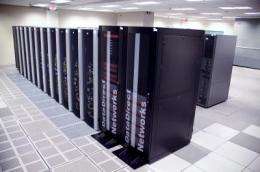Green 'Oakley Cluster' to double OSC computing power

Researchers using Ohio Supercomputer Center (OSC) resources can now conduct even more innovative academic and industrial research by accessing Ohio's newest energy-efficient, GPU-accelerated supercomputer system.
"This strategic investment in a powerful, state-of-the-art computational system will boost the vital research being conducted at industrial facilities and in university laboratories across Ohio," said Chancellor Jim Petro of the Ohio Board of Regents. "The Oakley Cluster also will help Ohio colleges and universities in their development of a highly skilled workforce by invigorating the state's innovative computational science education programs."
Available for general use beginning today, OSC's new $4.1 million HP-built, Intel Xeon processor based supercomputer, dubbed the Oakley Cluster, features more cores (8,328) on half as many nodes (694) as the center's most recent flagship system, the IBM Opteron™ 1350 Glenn Cluster. The Oakley Cluster can achieve 88 teraflops, which is tech-speak for performing 88 trillion calculations per second. With acceleration from NVIDIA Tesla graphic processing units (GPUs), the system has a total peak performance of 154 teraflops.
The new system provides nearly twice the memory per core (4 gigabytes) and three times the number of graphic processing units or 'GPUs' (128). The Oakley Cluster also provides researchers with one and a half times the performance of the Glenn Cluster at just 60 percent of Glenn's power consumption and will expand OSC storage to nearly two petabytes with the addition of 600 terabytes of new DataDirect Lustre storage.
OSC is a state-funded high performance computing center that provides Ohio's universities, industries and other clients with computation, software, storage and support services. OSC's centralized support increases the opportunities for researchers statewide to innovate and successfully compete for grants and national supercomputing resources. Major users of OSC's resources have focused on research in the areas of the biosciences, advanced materials, energy and the environment.
The new system arrived Dec. 28 on the west campus of The Ohio State University, where engineers have been working to assemble the complex system, install various software packages and test-run the system by allowing access to a few selected "power users." Earlier, the engineers made room for the Oakley Cluster by removing the older half of the Glenn Cluster, which in December logged its 150 millionth hour of computational use by OSC clients.
"A recent survey of Ohio universities indicated that researchers who leverage OSC resources annually garner more than $140 million in research funding – a huge return on investment for the state," explains Ashok Krishnamurthy, interim co-executive director of the center and senior director of research. "And, as we deploy each powerful, new computational system, we see our researchers react by leveraging even more sophisticated applications to analyze even larger data sets to solve even more complex science and industrial problems."
Among many OSC initiatives that will benefit from the features of the new system are the Blue Collar ComputingTM (BCC) program and the virtual Ralph Regula School of Computational Science. One of the center's most pioneering projects, BCC provides high performance computing for small- and mid-sized companies that do not have the time, money, or expertise to invest in supercomputing resources. The Ralph Regula School, developed through funding from the National Science Foundation, coordinates computational science education programs statewide that lead to a baccalaureate minor, an associate degree concentration and a workforce certification.
"The school empowers the workforce with the computational science knowledge and skills for additional employment and advanced education opportunities," said Steven Gordon, interim co-executive director of OSC and executive director of the Ralph Regula School. "Following the wider deployment of the Oakley Cluster, OSC will offer training with the new system, including such topics as parallel programming and various languages."
The Oakley Cluster's 2012 deployment coincides with the 25th anniversary of the establishment of the center in 1987 to place Ohio universities and industry at the forefront of computational research. OSC is a member of the Ohio Technology Consortium, the technology arm of the Ohio Board of Regents, and is located on the west campus of The Ohio State University.
Provided by Ohio Supercomputer Center




















